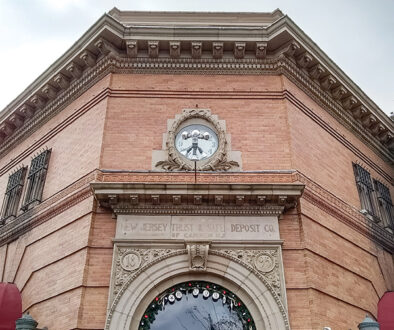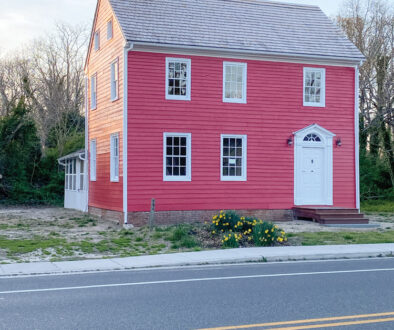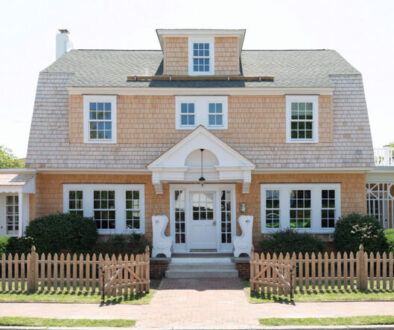Our Neon Neighbor

In the 1950s and 1960s, Wildwood was a town where bungalows and old, boxy boarding houses by the beach were being replaced with the newest motels, complete with air conditioning in the rooms, zig-zag balconies and jutting rooflines, and a slide into the pool outside. The Wildwoods became a mecca for the post-World War II nuclear family, where boomer teens could steer a surf green Chevy down Pacific Avenue with a gal on the bench seat and Buddy Holly on the AM, cruising toward a world without war and its prefab suburbs—and maybe even outer space.
More often than not, it was just a Saturday night at the Satellite Motel or the Kona Kai, a stolen kiss on the dark Jungleland Cruise on Hunt’s Pier, and blueberry syrup on the pancakes at Uncle Lou’s in the morning. Still, it felt like nowhere else. It still does, to an extent, and there’s a growing number of concerned business owners, leaders, and sentimentalists trying to keep the magic from slipping away, from letting Wildwood turn into every other shore town.
Intellectuals might describe the look of this Jersey Shore getaway as mid-century modern architecture if they’re discussing it in a classroom, and yes, the Wildwoods have been studied in universities all over the country. In California it’s referred to as the “Googie” look. There are examples of mid-century modern in a “this looks familiar to me in some weird way” feeling in Palm Springs, Miami Beach, Las Vegas, up in Niagara Falls, and between the tumbleweeds and gas stations across Route 66.
In the Wildwoods, all the way from the Crest in the south to Hereford Inlet at its northernmost end, they call it Doo Wop, the two words that describe a nonsensical yet fun way to sing, but here it means so much more. Doo Wop styles, according to the resort’s Doo Wop Preservation League, are broken into distinct subsets, including Vroom, Modern, Pu-Pu Platter or Tiki, Chinatown Revival, Phony Colonee and perhaps the best, Just Plain Wacky. There’s nothing quite like it, en masse, anywhere else in the world. The Wildwoods, a collective name for the four municipalities that make up the vacation destination, have doo wop in the diners and restaurants, on the raucous, free-wheeling boardwalk and even in the convenience stores, but it’s the motels—miles and miles of standard, L-shaped cinderblock units gussied up in a retro kitsch you either love, twist your head at, or obsess over—that really stand out here.
It looks like hot pink personified and feels like an electric guitar with a sunburst finish. If the Wildwoods had a voice, the hotels here would sound like the intro to Blue Moon by The Marcels in 1961: “Bom ba ba bom ba bom ba bom bom ba ba bom ba ba bom ba ba dang a dang dang. Ba ba ding a dong ding…”
The resort does have its own hit, with Bobby Rydell’s Wildwood Days, a song you’re bound to hear a few dozen times if you spend a weekend here come summer. Chubby Checker unveiled the twist here, and Bill Haley and his Comets may have given birth to rock n roll when they played Rock around the Clock on Memorial Day weekend of 1954 at the HofBrau Hotel at Atlantic and Oak Avenues.
Longtime vacationers all have their sentimental favorites up and down Ocean, Atlantic, Pacific and New Jersey Avenues. There’s the Lollipop Motel in North Wildwood, a self-described “candy-colored piece of Americana” as sweet as the 1954 Chordettes song of the same name, and the stately Carideon Motel across the street in gold and cardinal.
The Moreys, the first family of the Wildwoods who may have single-handedly ushered in the unique look, built the “neo doo wop” Starlux Boutique Hotel in 2000 in Wildwood. The Pink Champagne, an adorable little hotel, sits catty-corner. It was built in the ’50s and Wildwoodowop.com describes its look as “vroom.”
The Caribbean is recognized by many as the crown jewel of Doo Wop in the Wildwoods, or its most dazzling hood ornament, if you will. It was built in 1958 by Lou Morey, and features a yellow stucco façade, unique “floating ramp,” and a crescent-shaped swimming pool. The ramp, which curls up to the Caribbean’s sundeck from the ground floor, is affectionately known as the “Jetsons” ramp, an homage to the 1962 TV show that, like the Wildwoods at the time, looked toward a futuristic utopia that included sharp angles. The motel is also rumored to be the first at the Jersey Shore to plant the plastic palm trees that still rise up there today.
George Miller, who owns The Caribbean with his partner Carolyn Emigh, used to vacation in Cape May as a boy. The surf had waves in Cape May and the beach was filled with sand, all the Victorian houses a delight to behold, but Miller said he always anticipated the few fun-filled hours he’d spend in Wildwood.
“That trip to Wildwood would make my day for sure,” Miller said.
Miller and Emigh live outside Washington D.C., but traveled to the island in the summer often, and couldn’t turn their heads from the Doo Wop in all its varied forms. They bought The Caribbean in 2004 and went to work, bringing in designers and architects to update the past and general contractors to fix all that time had wrought, like the warped and rotting sundeck.
“We got into the Caribbean because we fell in love with it when we saw it. There were many hotels from the ’50s and ’60s that needed a lot of attention, and many of them didn’t make it,” he said. “The Caribbean had a lot of deferred maintenance.”
Miller and Emigh’s careful attention to detail has paid off in its vacancy rate and in the realm of public relations, with the motel routinely being named a throwback destination by newspapers, travel magazines, television shows, and blogs. It’s been included among the Historic Hotels of America, taking up real estate next to New York’s Waldorf Astoria and the Peabody in Memphis, Tennessee.
The Caribbean and the Chateau Bleu, a simple, refined Doo Wop motel (refined for the Wildwoods, that is) with a heart-shaped pool in North Wildwood have both been named to the National Register of Historical Places To Visit.
Wildwood Crest is home to many grand tacky dames that call themselves “ocean resorts” now. There’s the Crusader and the diminutive Aztec, along with the majestic Royal Hawaiian and its lava rock façade. America was obsessed with its new, exotic state in the South Pacific and all things Polynesian in the Doo Wop era. There’s a whole subset of “Tiki” culture there that’s growing as we speak. The Ala Kai, which means “by the sea” was built in 1963, and The Waikiki with its thatched-hut look and rooftop coffee bar was built in 1969. The Ala Moana, one of the last Doo Wop motels to be built, was erected in 1978.
There was also the Tiki Motel, the Tahiti Motel, the beautiful Kona Kai from 1969, and the indescribable Thunderbird Inn. And they’re all gone today, along with many, many others, cleared by a big wave of wrecking balls and hauled away by bulldozers to make way for condominiums during a Jersey Shore building boom in the mid-half of the new millennium.
The loss of so much Doo Wop—hundreds of hotels and diners and peculiar little stores and bars—is the reason the Doo Wop Preservation League was created in 1997. According to its web site, doowopusa.org, the league was founded in “response to studies conducted by the University of Pennsylvania, Yale University and Kent State University, validating and crediting the Wildwoods with having the largest collection of mid-century commercial (or “Doo Wop”) architecture in the nation.”
Jack Morey, co-owner of the Morey’s Pier Organization, was the founder of the league and is still on its board of trustees. Morey’s a different kind of guy, a businessman with an artist’s heart, someone who pauses for a moment before he speaks, and he’s got a lot of thoughtful things to say about preserving Wildwood’s unique past while forging a future at the same time.
“I always really tried to understand the macroeconomics of the seashore, but I was not the first to be concerned about Wildwood,” Morey said recently from his office on Mariner’s Landing Pier. “Once I got the bug though, I got the bug bad.”
Morey had a specific “aha!” moment on July 26, 1996 when he received a memo from Steve Izenour, an urbanist, theorist, and architect with Venturi Scott Brown & Associates in Philadelphia. The subject of the memo was “Wildwood Boardwalk” and Morey still reads it from time to time to keep everything in balance. He’d like everyone to read it.
“Have you read the Izenour letter? What’s your e-mail?,” he asked.
Izenour, described by The New York Times as an “architect of American pop” in his 2001 obituary, begins by telling Morey that Wildwood should never, ever try to be Disney. In fact, Disney and the Orlando theme park world has taken some pages from Wildwood. Universal Studios’ Cabana Bay Beach Resort in Orlando, built in 2014, could park anywhere along the beach in Wildwood Crest and feel at home. Izenour, in his memo to Morey, urged him to stay unique.
“What Wildwood is, is one of the last really down and dirty, TACKY with a capital T, beach resorts. What you need to do is take tacky to new heights. In an increasingly homogenized commercial world it’s the perfect counter punch strategy, and given the years of ad hoc evolution it took to make it what it is, nobody, not even Disney could beat you at your game,” he wrote.
To say the memo stuck with Morey is an understatement.
“There wasn’t a real culture of happiness down here at the time. A lot of people were looking for bulldozers at the time,” he said. “The letter and memo were profound to me. I almost cry when I read it.”
Morey and a group of business and hotel owners formed the league with the goal to preserve what was left and protect them from the condominium boom all around them. The league looked to Miami Beach, which protected its 1930s architecture, and neighboring Cape May’s efforts to keep its Victorian architecture intact.
Stephanie M. Hoagland, who works in architectural conservation for Jablonski Building Conservation in New York City, spent an entire summer living in a Wildwood boarding house and bicycling up and down the resort as an intern with the Doo Wop Preservation League in 2001. She loved neon and like many others, The Caribbean is her favorite. Hoagland tried to work on a historic preservation district with Morey but found that giving business incentives, like tax credits for registering as a historic landmark, worked better there than strict zoning laws that may have forced people out. Hoagland wrote an entire essay about the issue titled, “The Rise, Fall, & Resurrection of Wildwood’s Doo Wop Motels” that can be found at gardenstatelegacy.com. In it, she described how the boundaries of the proposed historic district couldn’t keep up with the number of demolitions between 2001 and 2006. She concluded by saying the Wildwoods could be in danger of losing the “sense of place” they once had by the bucketful.
“I haven’t been down in the past couple of years. Sometimes it’s just too depressing,” Hoagland told Cape May Magazine. “They’ve built more condos and they have no personality.”
Though the creation of a historic district ultimately didn’t pan out, Wildwood was able to get a Doo-Wop themed Wawa—arguably the coolest of all its stores up and down the East Coast—along with the Doo Wop Diner on the boardwalk, the Pink Cadillac Diner down on Atlantic Avenue, the Star Diner and Cool Scoops Ice Cream in North Wildwood.
Paul Russo, owner of Cool Scoops, said he was born on the day Buddy Holly died. Doo Wop is in his blood, and he even studied it as an architecture student in New York, where he grew up.
“This is our 15th summer,” Russo said. “I came down here because of Doo Wop. This place used to be little Las Vegas, with Jerry Lewis and Tony Bennett playing all the time. Even if the architecture goes away here, the history will remain.”
At Morey’s Starlux hotel, guests can spend a night in an Airstream trailer, another gleaming symbol of America’s newfound love for the road after World War II. Morey is also building at a 27-hole mini golf course close to the Starlux with three themes: beach, ocean, and boardwalk.
The former Surfside Restaurant, with its unique pinwheel roof, was disassembled from where it stood in Wildwood Crest since 1960 and moved north to Wildwood’s Fox Park, where it was rechristened the Wildwood Doo Wop museum during “Salute the ’60s” weekend in April 2007. The neon garden outside grows nostalgia with signage from the former Swan and Satellite Motels rising like glowing tombstones.
The Doo Wop Preservation League also hosts walking and guided tours, and there are theme parties large and small almost every weekend from April to October. There are moments down there when everything still aligns, maybe if the classic car show is around or the Wildwoods are celebrating music of the ’50s, when the past seems alive in all its retro glory.
Morey, a surfside theorist himself, isn’t beholden to doo wop as the only answer for the Wildwoods. The beach, after all, is the attraction in all the shore towns from Sandy Hook to Cape May. He still looks back to Izenour’s memo when he thinks about what the resort will look like in coming decades, though, and he settles on one word, a mantra he repeats, to set Wildwood apart, even if another neon wonder comes crumbling down.
Unique.
“I feel pretty good about it. I like our chances, I like where we are here,” he said. “It’s been very purposeful here to make Wildwood look different than other places, and we have to stick to that. We can always have a little tacky, a little Doo Wop, but most importantly, we have to just be a little different from anywhere else.”


















